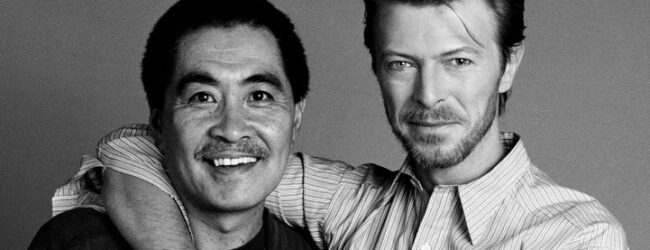
Masayoshi Sukita has taken some of the most striking photographs of David Bowie, ever. Not only have his photos graced Bowie’s album covers, but they also collaborated consistently on multiple sessions, both professionally in a studio and in a candid manner. No other photographer captured Bowie throughout as many eras as Sukita did, making their creative relationship one of the most fascinating, enduring and vital in Bowie’s visual output. In Bowie’s own words: ‘It’s very hard for me to accept that Sukita-san has been snapping away at me since 1972 but that really is the case… May he click into eternity.’
Sukita-San, thank you so much for taking the time to do this interview. Before getting into the various eras of your Bowie collaborations, let’s start with your early life. Can you tell us how you became interested in photography?
In my childhood, my family used to take me to theatres to watch movies. It must have ben a starting point for me to become interested in “visions”.
When I was 18 or 19 years old, my mother bought me a camera even when my family was poor just after WWII – my father died in the war. So that age was the point that got me into photography in an earnest fashion.
Who were the photographers that you admired and inspired you back when you were first learning how to take photos?
Eugene Smith. I still like his works.
Did you become an expert at taking pictures by practicing or did you have a formal education?
I entered college to study photography but I had learned enough from books by myself before the formal education.
What were your first assignments as a photographer?
In my early twenties I used to work as an assistant of Shisui Tanahashi who was a well-known photographer in Osaka. One day he assigned me to take portraits of a woman that had requested photos intended for matchmaking and I did my best. Afterwards, the woman came to the office and told me her match was successful because of a portrait I took. It made me very happy.
You met Bowie for the first time in London, back in 1972. History says you were struck by one of his posters and you were determined to photograph him because of that. Can you elaborate on your impressions of Bowie the first time you met and how you worked on your first session?
Yes, when I visited London to shoot T.Rex in 1972, I coincidentally saw Bowie’s poster on a street. I was interested in him then and contacted his management to ask to have a photo session.
My first impression of him was “Cool guy”. He looked very relaxed with glasses of wine during the session.
When you began collaborating with Bowie, language was probably a barrier due to him not speaking Japanese, and you not speaking English as much yet. However, both of you overcame this barrier and created beautiful work. Did you ever establish this kind of connection with any other subject?
Yes, I was able to have good collaborations with T.Rex -Marc Bolan and Mickey Finn, Iggy Pop etc…as with Bowie.
You were then present at his legendary concerts at The Rainbow Theatre. What recollection do you have of seeing Bowie performing live at that time?
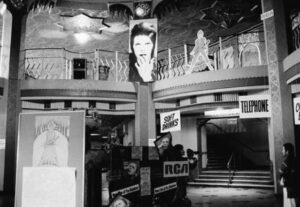
Above, The Rainbow Theatre Foyer.
I was surprised he was miming with Lindsay Kemp on the stage. It was almost my first experience of shooting a rock concert.
In the photo I think I am in the centre behind the RCA signboard. The one on the right one seems to be my Japanese journalist friend.
Your next collaboration took place in 1973, in New York. By then, in just a short time-span, Bowie had transformed completely. Please tell us about the incredible session you did with the Kansai Yamamoto outfits.
Yacco, a Japanese stylist of my friend suggested Bowie to wear Kansai’s costumes, because she had supported Kansai’s fashion show in London a year before. Most of the costumes were for women, but they fit Bowie perfectly. At the time RCA (which was Bowie’s record company) was promoting him a lot so I could use RCA’s photo studio. I could make some iconic photos of him in this session.
Your next live experience was seeing Bowie perform at Radio City Music Hall in February of 1973, a few days after the photo shoot. These concerts were completely different to what you had witnessed at the Rainbow Theatre, and the set lists now had a lot of Aladdin Sane songs. What was your impression of the new show?
It seemed he and his record company were putting a big effort into promoting David Bowie in the US. It was held 14th of February, on Valentine’s day. Everything about the live show including the audience looked perfect, but to be honest, I was concentrating on shooting every moment of the concert, so don’t remember the song details.
You then captured Bowie performing in Japan for the first time. By this time, the shows had become more intense and the outfits were more outrageous. What memories do you have of the Japanese crowd and the tour at the time?
He came by ship and many fans went to see him to Yokohama port were he arrived at. He was waving his hands to the fans from the ship. The concerts were great as in UK or US – it was the first time Bowie had played concerts for Japanese fans. I remember the audiences were very enthusiastic.
In 1977 you photographed Bowie again as he visited Japan for press and promotion purposes. Out of this occasion, one of the most iconic Bowie images was born: The “Heroes” album cover. I understand this was simply meant to be a promo session, and you were not intending to make an album cover. However, Bowie liked one of the images so much, he asked you if he could use it. Can you share with us some insight into this legendary session?

He came to Japan with Iggy Pop to promote his new album “The Idiot”. This time because he had produced the album. I heard their schedules were not very tight because it wasn’t a tour, so I asked him and Iggy to have a photo session. He just requested Yacco get him some leather jackets for that. The sessions were held for 1 hour with each (Bowie & Iggy) and they looked very relaxed.
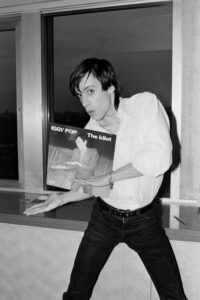
After the sessions, I selected and printed some of the best ones and sent him the prints. Some days later he told me he would love to use one for the sleeve of his new album “Heroes”. I was very honored and pleased with it!
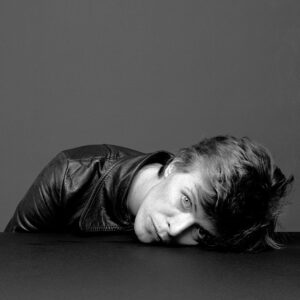
Bowie returned to Japan in 1980. For the occasion, you captured multiple candid shots of him out and about in Kyoto. Several of these photos are beautiful and capture what look like timeless moments. What was it like for you accompanying Bowie in this environment, as opposed to the studio sessions?
He came to Kyoto for filming a commercial of Japanese liquor then. He contacted me to have me shoot him in the city after the commercial filming. There was no reason to decline for me. I suggested to him we shoot photos in “loco” places, instead of so-called “Japanese” places as temples or shrines. Bowie drove a rented car by himself around the city, it was like I used him as a taxi driver! I am still sure that my intensions were right. Some of the photos from this session are very nice and interesting.
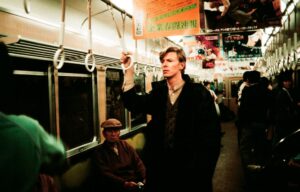
During his visit, you did find some time to work in the studio. This time the session spawned a very interesting set of photos with a concept: Bowie as a businessman, posing with a clock missing numbers in the back. Can you tell us about this intriguing session?

After Kyoto, I asked him to have another session in Tokyo before he left Japan. I suggested we made a figure and he suggested the businessman and clock ideas.
The clock has only 1 to 10 on the board, it means businessmen are too busy to have time of 12.
Fast forward to 1989. Can you elaborate on this photo please?
I knew he had grown his beard after a movie “Merry Christmas, Mr. Lawrence”, so I asked him to take pictures and visited him in NY just to shoot “beard Bowie”. I thought he was transforming into a new Bowie.

You were then working with Bowie again but at that point he was part of a band. You captured what would become the cover of the first Tin Machine album, presented in different configurations with the band members arranged in different positions. What was it like photographing Bowie in this new format?
When I visited him for the “beard session”, he asked me to shoot photos of his new band – Tin Machine – for the first album’s jacket. It was challenging for me to shoot the band because I had to capture the best moment of not only Bowie but also the other members. At the same time it was interesting to see each members having unexpected movements.
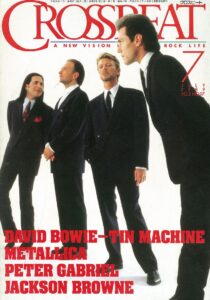
You then took some great shots in 1992 during the second era of Tin Machine. Out of these photos, one stands out particularly:
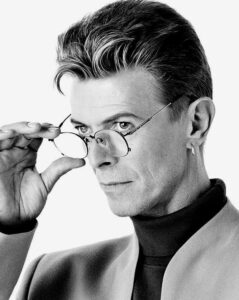
First of all, let me tell you that this is one of my favorite photographs of Bowie of all time, I found it striking since the first time I saw it. Also, It seems like you found the particular photo very special too, considering it became the front cover of your Ki book, correct?
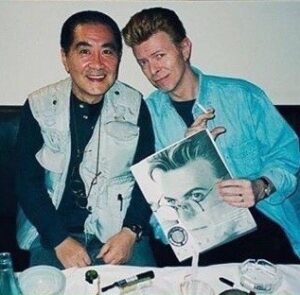
It was fun to shoot the band as I mentioned. Bowie was very thin at the time and I was pretty surprised.
And yes, I liked the image of Bowie with the glasses, so I chose it for the cover of “Ki”.
Next, you captured Bowie live during the 1996 leg of his Outside tour. In this particular shot, you caught Bowie performing in a very dramatic pose. The result is mesmerizing.

A photo like that one is truly a special moment to capture…in a similar vein, this shot from 1978 were you caught Bowie emulating the “Heroes” pose is quite striking:

Above, from Speed of life, Genesis Publications, photo courtesy of Francisco Beristain.
These photos show your talent for snapping at just the right moment during a live setting and coming up with amazing shots that stand out from regular live photos. How did you manage to be so on point during concerts? Is it a matter of luck?
It’s all just my random thoughts, I don’t understand English at all so lyrics never stimulated my ears during his concerts. I think it worked well to concentrate to take photos. Plus I’d had many opportunities of shooting Bowie live, I could guess what was going to happen next then I could get ready for next shutter-chances.
Can you tell us about the session you did at Bowie’s office in New York in 2009? Only one photo from this encounter was included in Speed of Life:
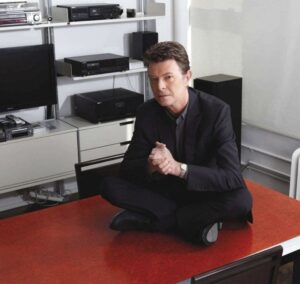
Were other photos taken, and do you plan to show them at some point in the future?
I visited NY to attend a rock photo exhibition at the Brooklyn Museum (my photo was exhibited). I asked him for another session. It came true, but sadly he was too busy to have enough time for this. I remember he liked the red table in the photo.
There are some more from this session, but again, we didn’t have enough time to shoot many. I am not sure I will show the other photos in the future.
Finally, let’s talk about your Bowie books. Ki, Spiritual Force, published in 1992 is now a collectors item and cannot be obtained easily. What is the back story of this book and how did you put it together?
I really don’t remember how the project started…Tokyo FM Publishing (publisher of this book) approached me, maybe?
My first idea of this book’s title was simply “Photo Session”, but it was changed to “Ki” which is a very Japanese philosophical word (it means a bit like “Spirit”). I think Bowie liked the word because he was very interested in Japanese culture.
A few years later, an incredibly ambitious project came to fruition: The stunning Speed of Life book.

Out of all the Genesis Publications books about Bowie, Speed of Life is undoubtedly the most beautiful and special. What was it like for you collaborating with Bowie to put together this book and going through all your sessions together to choose the photos?
The project took 7 years to be published. Genesis Publications and I started the project, and Bowie joined when the publisher contacted him to let him know about this book. He was quite interested and wrote some essays for this (and also agreed to the signatures).
After the book was released, I heard that Jimmy Page was interested to make his book just like “Speed of Life”. I’m proud of this book.
What was your impression of “The Next Day” cover when you saw it for the first time?
Bowie hadn’t let me know in advance about it at all, so I was very surprised when I saw it for the first time! He didn’t do interviews about this. At the time, many media outlets all around the world, even from Brazil or Russia asked me about the album jacket.
I had no ideas and was a little bit confused. It’s an interesting concept that makes the image “newer”. Now when I think of this, I’m honored and proud that my “Heroes” photo could be the only one which was used for two different albums.
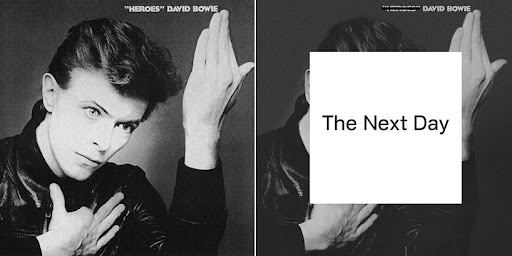
More recently, you published Sukita: Eternity. This book not only features Bowie, but it also covers several stages of your career, from music to fashion and everything in between. Can you tell us what compelled you to make this new book?
Iconic Images which produced the book suggested it first. When I visited their office in London, Terry O’Neill appeared to see me. Iconic and Terry-san showed me his photo book covering his whole career made by them. I was impressed by the book and wanted to make a retrospective photo book of myself.
When the project started moving, Covid occurred… But at least it worked well to proceed with the book project. Because I could find the time to look for photos in my archives for the book.
I really appreciate that Iconic Images and ACC gave me a chance to produce this book.
Recently, there was a documentary about your life and work. Will it be available outside of Japan at some point?
I heard the distributor of the film is working on it. Actually it was shown in some film festivals or events in some countries. I hope it will be properly released in other countries someday.
Finally, can you tell us what’s next for you in terms of exhibitions, books and projects?
I joined “Rock the Photo” currently held in Valladolid in Spain.
I am planing to re-start an exhibition in Kyoto which was forcefully cancelled by Covid this year. The title will be “Bowie x Kyoto x Sukita”, based on Bowie in Kyoto in 1980 + new Kyoto photos by me. It will be opened in June 2022 probably.
Another big exhibition in Fukuoka (where I am from) is also planned – hopefully it will be held in 2023.
Thank you so much!
————————————————————-
Many thanks to Sukita for taking the time to do this interview.
Many thanks to Aki Sukita, your assistance is infinitely appreciated.
Interview by Francisco Beristain & Nick Vernon, exclusively for David Bowie News. © 2021.
Edited by Nick Vernon.
Main image of Bowie & Sukita © Mark Higashino.
All images © Masayoshi Sukita, unless otherwise stated.